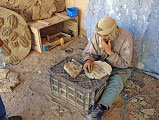FRANKFURT | CASABLANCA | ROAD TO FEZ | FEZ | ROAD TO ERFOUD | ONWARD TO OUARZAZATE | ROAD TO MARRAKECH | MARRAKECH | TUNISIA | CARTHAGE | DOUGGA/BULLA REGIA | DUBAI | AL MAHA | OMAN | SALALAH |
ONWARD TO OUARZAZATE I ate something in the last day that decided to turn around and eat me. Consequently, I decided to pass on the guide's offer of starting a pre-tour journey to some relatively nearby Sahara sand dunes. Carol, on the other hand, leapt at the opportunity. She bounced along in a four wheel drive vehicle over washboard roads for an hour and got to see the sun rise over the mighty Sahara. She also rode a camel. With the guide not yanking on his tether and making it look straight ahead, the camel decided to say hello to his rider when the guide was taking this picture. I ate something in the last day that decided to turn around and eat me. Consequently, I decided to pass on the guide's offer of starting a pre-tour journey to some relatively nearby Sahara sand dunes. Carol, on the other hand, leapt at the opportunity. She bounced along in a four wheel drive vehicle over washboard roads for an hour and got to see the sun rise over the mighty Sahara. She also rode a camel. With the guide not yanking on his tether and making it look straight ahead, the camel decided to say hello to his rider when the guide was taking this picture.
Today's drive was really a continuation of the previous day. It was the next link of a circular route that is taking us through Berber tribal areas and cities in middle Morocco. Our guide Hassan, who is part Berber, took pains to point out differences in the various Berber tribes (colors the women wore and how they draped their veils, for example). Whatever the differences, the inhabited portion of the landscape  took on a comfortable similarity. There were clear differences between simple shepherd villages, small and poor communities, and the larger cities, but these differences might be found anywhere. took on a comfortable similarity. There were clear differences between simple shepherd villages, small and poor communities, and the larger cities, but these differences might be found anywhere.
But there were certain characteristics that stood out. Outside of the large and well known cities, land is cheap and plentiful. That allows even those with modest means to move from adobe to concrete as a building material. Instead of tearing down the existing adobe home, a new structure is simply built next door or nearby. A large scale example of the abandonment of adobe structures was the move to Israel of a couple of hundred thousand Moroccan Jews in the 1940's after Israel was founded. The adobe homes they left are unoccupied ghost towns and new complexes have sprung up along side the ones they left. One unhappy reminder of western civilization in Morocco is the plastic bag and plastic water bottle, which are seen all over the desert. The Bedouin are used to leaving trash in the desert and moving on, because for many centuries that trash was totally organic and nature would dispose of it. The American Indian had much the same pattern. That certainly doesn't happen with plastic, as we all too well know. When we lived in West Virginia, we spent a short period of time searching  for fossils, mostly trilobites. The ones we found were half to an inch long. The trilobites from Morocco are six inches long and more. We were taken to a shop that mined these fossils from a site near our "New Mexico" hotel. Many of the fossils are encased in marble and are cut and polished as plates, ash trays, tables and the like. We were thinking (for about two nanoseconds) of sending back a couple of slabs and redoing our kitchen countertops. for fossils, mostly trilobites. The ones we found were half to an inch long. The trilobites from Morocco are six inches long and more. We were taken to a shop that mined these fossils from a site near our "New Mexico" hotel. Many of the fossils are encased in marble and are cut and polished as plates, ash trays, tables and the like. We were thinking (for about two nanoseconds) of sending back a couple of slabs and redoing our kitchen countertops.
 Our lunch stop was in a gorge (called by the guide "gorgeous gorge"). It was a place much visited by tourists (we saw our friends from the Smithsonian again) but it also had a number of hikers and climbers from all over the globe. As it turned out, the drive to the gorge, with fabulous adobe villages clinging to the cliffs and spread along the river valley, was actually more spectacular than the final destination. Our lunch stop was in a gorge (called by the guide "gorgeous gorge"). It was a place much visited by tourists (we saw our friends from the Smithsonian again) but it also had a number of hikers and climbers from all over the globe. As it turned out, the drive to the gorge, with fabulous adobe villages clinging to the cliffs and spread along the river valley, was actually more spectacular than the final destination.
|
|
| TURKEY AND GREECE | CIRCLE THE ARCTIC |